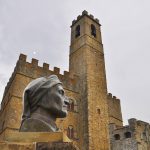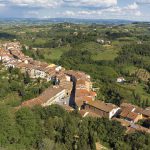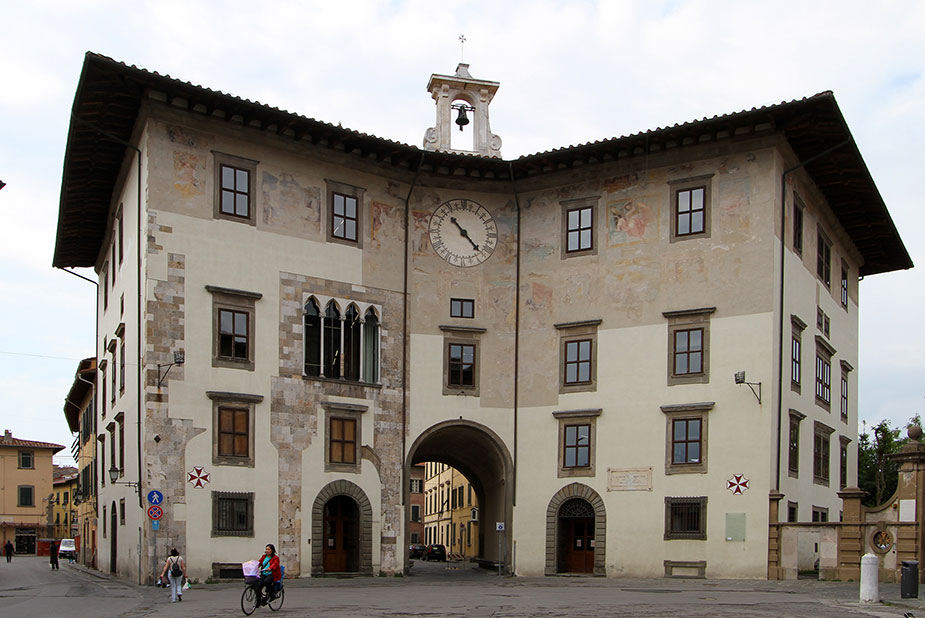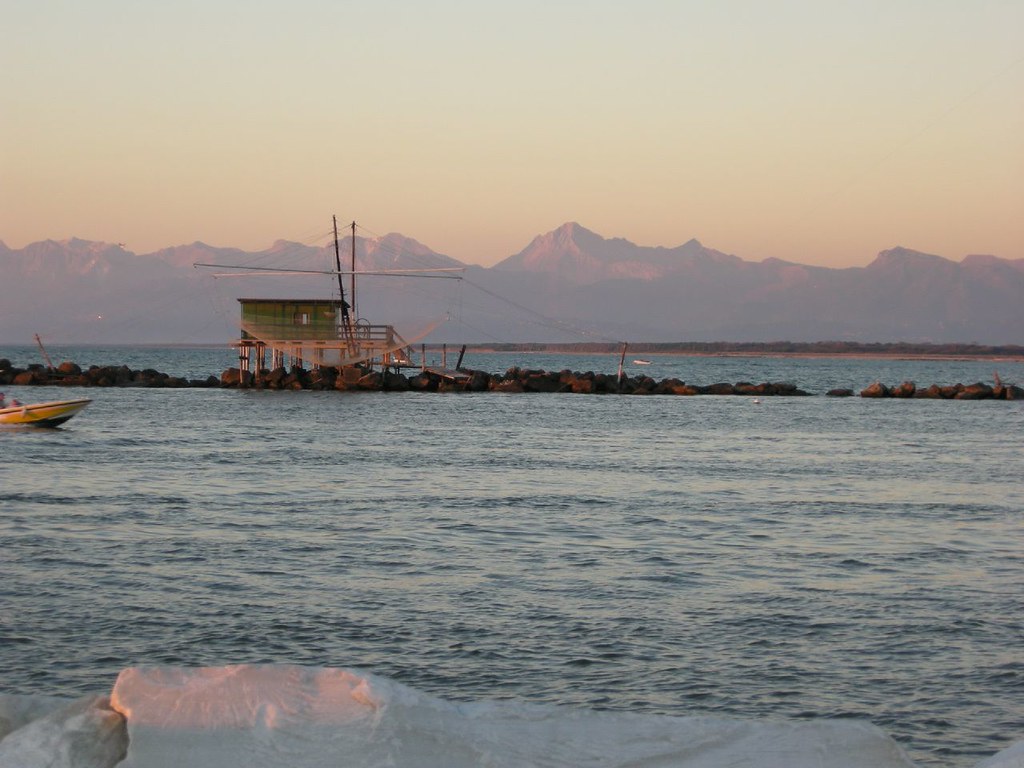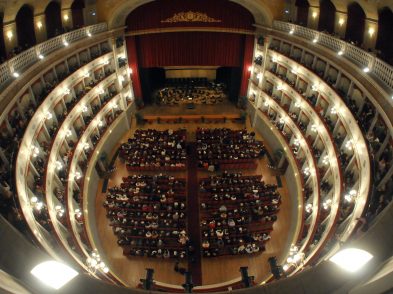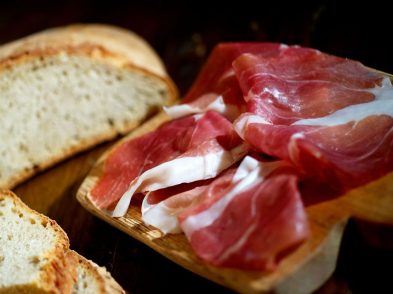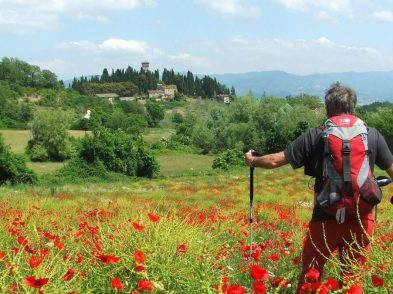- Poppi Castle (nonmisvegliate)
- Campaldino Plate, San Miniato (Sailko)
- Romena Castle (Sailko)
- San Miniato (Alessandro Squassoni)
- Torre della Muda (Carlo Pelagalli)
- Pratomagno (Tomphgallery)
- Marina di Pisa (mstefano80)
Baptized Durante di Alighiero degli Alighieri and often referred to simply as Dante, the Florentine poet, writer and philosopher stayed true to his Tuscan identity throughout his years spent in exile, mentioning or referring to countless evocative corners of the region in his seminal work, the Divine Comedy.
Casentino: “green hills with channels cool and moist”
Dante nurtured a deep affection for Casentino. Hosted by the Guidi counts, the forested area in eastern Tuscany is where the poet spent several years of his exile from Florence. Dante’s Casentino experience began on the Campaldino plain, where the battle of the same name was fought between the Florentine Guelphs and the Ghibellines of Arezzo on June 11, 1289. The Guelphs decided to tackle downhill with a defensive strategy, while the Ghibellines opted to hit their enemies centrally as 12 riders led the charge under the command of Bonconte da Montefeltro. Dante, just 24, was one of these frontline soldiers, who played a crucial role in Arezzo’s victory. His memories of the frightening battleground are replayed in Canto 5 of Purgatorio: Là ’ve ’l vocabol suo diventa vano, / arriva’ io forato ne la gola, / fuggendo a piede e sanguinando il piano | There, at the place where that stream’s name is lost, / I came—my throat was pierced—fleeing on foot / and bloodying the plain.
In 1310, Dante stayed at Poppi Castle as a guest of the Guidi counts. It’s believed that the scholar penned Canto 33 of Inferno in this imposing 12th-century stronghold that dominates the entire valley. One of the best-known verses in the Divine Comedy, the canto revolves around Count Ugolino della Gherardesca, with whom the Guidi lineage were related through marriage. While remaining in the area, Dante explored the architectural wonders of the valley, such as the medieval castles of Romena and Porciano, as demonstrated by his mentions of Romena: Ivi è Romena, là dov’ io falsai / la lega suggellata del Batista; per ch’io il corpo sù arso lasciai | There is Romena, there I counterfeited / the currency that bears the Baptist’s seal; / for this I left my body, burned, above (Inferno 30: 73-75) and the story of Maestro Adamo, a forger employed by the counts who was burned alive in a place that is known as Omomorto (Inferno 30: 61). Dante’s genuine love for this verdant corner of Tuscany is revealed in his poetic description of the mountain streams: Li ruscelletti che d’i verdi colli / del Casentin discendon giuso in Arno, / faccendo i lor canali freddi e molli, / sempre mi stanno innanzi, e non indarno, / ché l’imagine lor vie più m’asciuga / che ’l male ond’ io nel volto mi discarno | The rivulets that fall into the Arno / down from the green hills of the Casentino / with channels cool and moist, are constantly / before me; I am racked by memory— / the image of their flow parches me more / than the disease that robs my face of flesh (Inferno 30: 64-69).
Strong, isolated and wreathed in silence, the Hermitage of Camaldoli was founded around 1046. The source of the Archiano flows just above the shrine and once marked the border between the Guidi-dominated Casentino and the territories ruled by Arezzo. The Archiano and its banks are mentioned in Canto 5 of Purgatory, when Bonconte da Montefeltro dies at the point where the Archiano flows into the Arno: «Oh!», rispuos’ elli, «a piè del Casentino / traversa un’acqua c’ha nome l’Archiano, / che sovra l’Ermo nasce in Apennino | “Oh,” he replied, “across the Casentino / there runs a stream called Archiano—born / in the Apennines above the Hermitage (Purgatory 5: 94-96). In the same canto, Dante references panoramic Pratomagno as the “great ridge” that separates the Casentino from the Valdarno and constitutes a natural monument for the Casentinesi. An iron cross was erected on the summit in 1928 in honor of St. Francis.
Another source is mentioned in Purgatory as Dante speaks about the fount of the River Arno: il fiumicel che nasce in Falterona | stream that arises in Falterona (Purgatory 14: 17). It’s plausible that Dante passed by the 1,650-metre mountain between Casentino and Romagna, given that he died in Ravenna in 1321, without ever having been able to return to Florence.
The poet’s respect for Casentino is seen in its elevation to Paradise. In Canto 11, readers find the Sanctuary of La Verna. Here, Dante’s verses refer to Saint Francis, who received the stigmata a couple of years before his death at this holy place in the Casentino mountains: nel crudo sasso intra Tevero e Arno / da Cristo prese l’ultimo sigillo, / che le sue membra due anni portarno | there, on the naked crag between the Arno / and Tiber, he received the final seal / from Christ; and this, his limbs bore for two years (Paradise 11: 106-108).
Pisa, Marina di Pisa + San Miniato: “the one who possessed both keys of Frederick’s heart”
Predictably from a proud Florentine, Pisa doesn’t enjoy the best of write-ups in Dante’s epic poem: Ahi Pisa, vituperio de le genti / del bel paese là dove ’l sì suona / poi che i vicini a te punir son lenti | Ah, Pisa, you the scandal of the peoples / of that fair land where si is heard, because /your neighbors are so slow to punish you (Inferno 33: 79-81). Our first stop is piazza dei Cavalieri, which was called piazza delle Sette Vie in Dante’s day and served as the city’s political administrative center. Canto 33 of the Inferno is set in the circle of the traitors, where we meet Ugolino della Gherardesca. Accused of high treason in Genoa’s naval defeat of Meloria, the politician was imprisoned with his four children in the piazza’s Torre della Muda. When the door was opened eight months later, five corpses were found that had been chewed, presumably by mice. Line 75 Poscia, più che ‘l dolor, potè ‘l digiuno (then fasting had more force than grief) is open to interpretation. We’ll never know if Count Ugolino really ate his offsprings’ corpses or if he died along with them in pain and sorrow.
In the Middle Ages, San Miniato was located along the Via Francigena and controlled the commercial traffic in Tuscany. Dante bears witness to the tragedy of Pier delle Vigne, personal counsellor to the Emperor Frederick II, who was falsely accused of high treason, imprisoned and blinded inside the fortress that still dominates the historic center: Io son colui che tenni ambo le chiavi del Cor di Federigo | I am the one who guarded both the keys / of Frederick’s heart and turned them (Inferno 13: 58-59).
Marina di Pisa, along the coast about 12 km away, is where the mouth of the Arno River flows into the sea after its 240-kilometre course through Tuscany: e faccian siepe ad Arno in su la foce | make a barrier at the mouth of the river (Inferno 33: 83). Visitors can contemplate Dante’s accomplishments while basking in mesmerizing views of the San Rossore Migliarino Massaciuccoli Nature Park, the Monte Pisano | per cui i Pisani veder Lucca non ponno | because of that, Pisans can’t see Lucca (Inferno 33: 30) and Apuan Alps mountain ranges. The stoic Rocca di Caprona, otherwise known as Torre degli Upezzinghi, can be seen when travelling along the slopes of Monte Pisano: così vid’io già temer li fanti / ch’uscivan patteggiati di Caprona / vegendo sé tra nemici cotanti | just so, I saw the infantry when they / marched out, under safe conduct, from Caprona; / they trembled when they passed their enemies (Inferno 21: 94-96). The episode takes us full circle to Dante’s time as a foot soldier away from Florence, fighting in Tuscany’s rolling hills and expansive plains.

September 14 marks the 700th anniversary of Dante Alighieri’s death. For this reason, events commemorating the poet are taking place all over Tuscany. www.danteotosco700.it / www.viedidante.it

